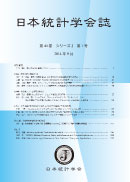Volume 44, Issue 1
Displaying 1-14 of 14 articles from this issue
- |<
- <
- 1
- >
- >|
Article
-
2014Volume 44Issue 1 Pages 1-17
Published: September 26, 2014
Released on J-STAGE: April 30, 2015
Download PDF (830K)
Special Section: Economic Analysis and Structural Change
-
2014Volume 44Issue 1 Pages 19-40
Published: September 26, 2014
Released on J-STAGE: April 30, 2015
Download PDF (1223K) -
2014Volume 44Issue 1 Pages 41-60
Published: September 26, 2014
Released on J-STAGE: April 30, 2015
Download PDF (1034K) -
2014Volume 44Issue 1 Pages 61-74
Published: September 26, 2014
Released on J-STAGE: April 30, 2015
Download PDF (849K) -
2014Volume 44Issue 1 Pages 75-95
Published: September 26, 2014
Released on J-STAGE: April 30, 2015
Download PDF (2023K)
Special Section: Covariate Shift and Density Ratio Estimation
-
2014Volume 44Issue 1 Pages 97-111
Published: September 26, 2014
Released on J-STAGE: April 30, 2015
Download PDF (790K) -
2014Volume 44Issue 1 Pages 113-136
Published: September 26, 2014
Released on J-STAGE: April 30, 2015
Download PDF (1272K)
Special Section: Developments and Future Issues in Macroeconometric Time Series Analysis
-
2014Volume 44Issue 1 Pages 137-157
Published: September 26, 2014
Released on J-STAGE: April 30, 2015
Download PDF (757K) -
2014Volume 44Issue 1 Pages 159-187
Published: September 26, 2014
Released on J-STAGE: April 30, 2015
Download PDF (1119K) -
2014Volume 44Issue 1 Pages 189-216
Published: September 26, 2014
Released on J-STAGE: April 30, 2015
Download PDF (1093K)
Special Topic: The JSS Prize Lecture
-
2014Volume 44Issue 1 Pages 217-240
Published: September 26, 2014
Released on J-STAGE: April 30, 2015
Download PDF (792K)
Book reviews
-
2014Volume 44Issue 1 Pages 241-242
Published: September 26, 2014
Released on J-STAGE: April 30, 2015
Download PDF (533K) -
2014Volume 44Issue 1 Pages 243-245
Published: September 26, 2014
Released on J-STAGE: April 30, 2015
Download PDF (539K) -
2014Volume 44Issue 1 Pages 247-249
Published: September 26, 2014
Released on J-STAGE: April 30, 2015
Download PDF (521K)
- |<
- <
- 1
- >
- >|
